Key Takeaways
For data eSIM in South Korea, our recommendation is eSIM4Travel. It provides:
- Competitive pricing.
- Great customer support.
- Smooth purchase and activation process.
If you prefer a provider with a native app, you will not make a mistake by going with the well-known Saily, but it's more expensive than eSIM4Travel.
Introduction
South Korea stands as one of the most technologically advanced destinations in Asia, attracting millions of tourists, business travelers, and digital nomads annually with its unique blend of ancient traditions and cutting-edge innovation.
When visiting this fascinating country, staying connected is essential, but traditional roaming can lead to exorbitant charges. Physical SIM cards require time-consuming visits to local stores, which is why more travelers are embracing eSIM technology – the modern, hassle-free solution that eliminates the need for physical cards.
This comprehensive guide focuses on the leading eSIM providers for South Korea, including eSIM4Travel, Saily, Global YO, GigSky, and Yesim. We'll examine their most popular data packages (2 GB, 5 GB, 10 GB, 20 GB, or unlimited) to help you select the optimal korea esim for your specific needs.
With an eSIM, you'll avoid excessive roaming fees and manage everything online before your trip. In the following sections, you'll discover installation guides, practical tips, and detailed price comparisons to ensure you enjoy seamless connectivity throughout your Korean adventure – without worrying about connectivity issues or unexpected charges.
eSIM Plans in South Korea at a Glance
- Cheapest eSIM package:
- Cheapest eSIM package 5GB:
- Cheapest eSIM package 10GB:
- Cheapest eSIM package 20GB:
- eSIM package with most GB:
- eSIM package with longest validity:
- Package with lowest price per GB:
Best eSIM Providers for South Korea
eSIM4Travel in South Korea - Most Budget-Friendly and great customer support
eSIM4Travel is an American eSIM provider with coverage in 170 countries, offering very competitive prices and reliable connection without an app.
 170 countries, local and regional eSIM plans.
170 countries, local and regional eSIM plans. No app, everything through website.
No app, everything through website. No app, everything through website.
No app, everything through website. Supports data top-ups.
Supports data top-ups. Hotspot allowed.
Hotspot allowed. No speed limitations.
No speed limitations. Simple installation and activation.
Simple installation and activation. Very competitive prices.
Very competitive prices. Excellent customer support.
Excellent customer support. Immediate functionality without restart.
Immediate functionality without restart. Mobile app is missing.
Mobile app is missing. Absence of unlimited data plans.
Absence of unlimited data plans.

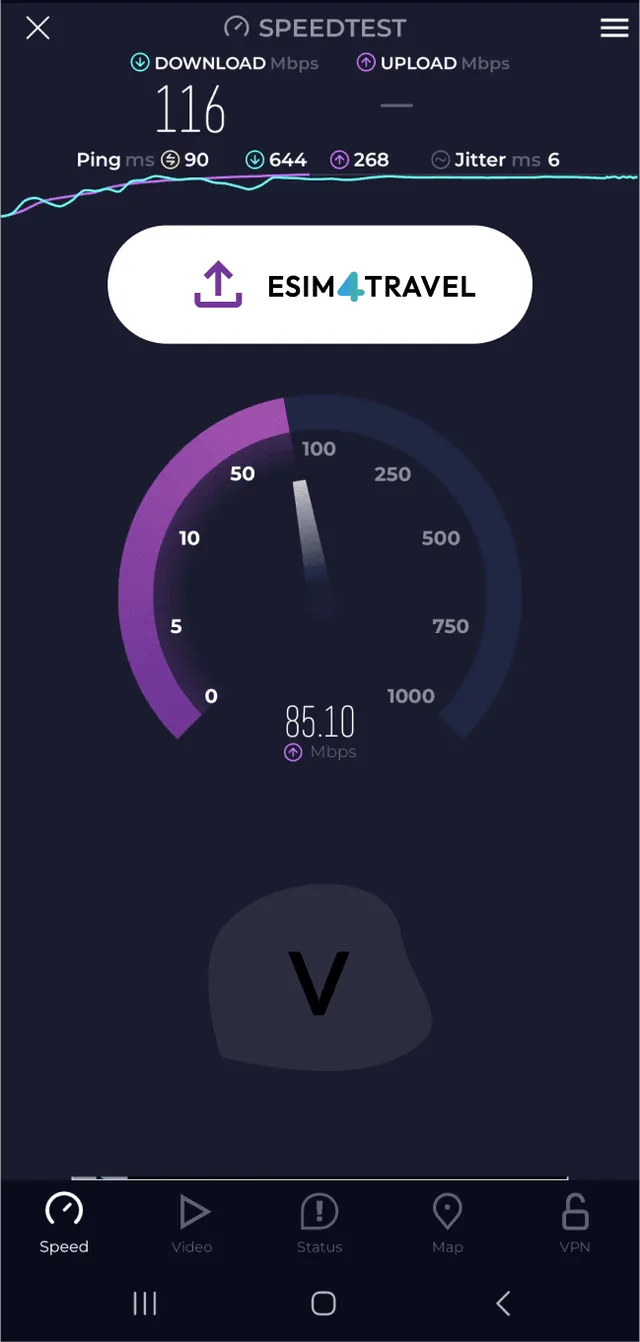

eSIM4Travel in South Korea uses the SK Telecom network, which offers exceptional coverage throughout the country. As South Korea's largest mobile operator, SK Telecom provides reliable connectivity in urban centers, rural areas, and even underground subway systems. For budget-conscious travelers seeking a dependable connection, eSIM4Travel presents an excellent value proposition. Their service typically activates immediately after installation, with responsive customer support that connects you directly to knowledgeable representatives. Their competitive pricing is among the most attractive in the market. Additionally, they don't impose speed restrictions, eliminate the need for app installations, and offer convenient data top-ups for your existing eSIM when needed.
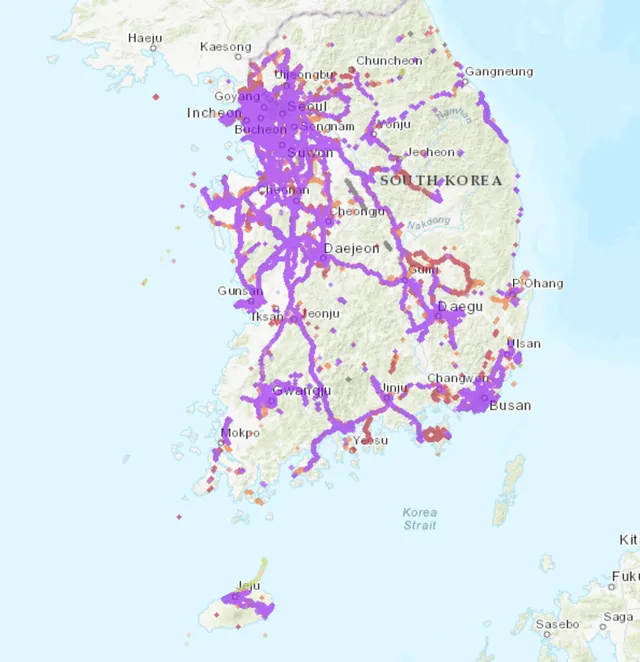
eSIM4Travel Plans in South Korea
Selection of the best eSIM data plans for ESIM4TRAVEL in South Korea from 2 GB.
Saily eSIM in South Korea - Best eSIM app
Saily is a modern travel eSIM provider created by NordVPN with coverage in 180 countries. It offers a top-notch app with sophisticated features like integrated VPN and fast customer support.
 180 countries, global, regional and local eSIM.
180 countries, global, regional and local eSIM. Excellent iPhone app. 4.6 from 2,000 reviews.
Excellent iPhone app. 4.6 from 2,000 reviews. Excellent Android app. 4.8 from 17,000 reviews.
Excellent Android app. 4.8 from 17,000 reviews. Supports data top-ups.
Supports data top-ups. Hotspot allowed for occasional use.
Hotspot allowed for occasional use. Speed limit for unlimited plan after 1GB/24h.
Speed limit for unlimited plan after 1GB/24h. Clear and intuitive app with modern design.
Clear and intuitive app with modern design. Very fast and efficient customer support.
Very fast and efficient customer support. Smooth eSIM installation directly from the app.
Smooth eSIM installation directly from the app. Need to install the app to get eSIM after purchase.
Need to install the app to get eSIM after purchase. App doesn't work after data depletion (no zero-rating).
App doesn't work after data depletion (no zero-rating). Problematic personal data processing from GDPR perspective.
Problematic personal data processing from GDPR perspective.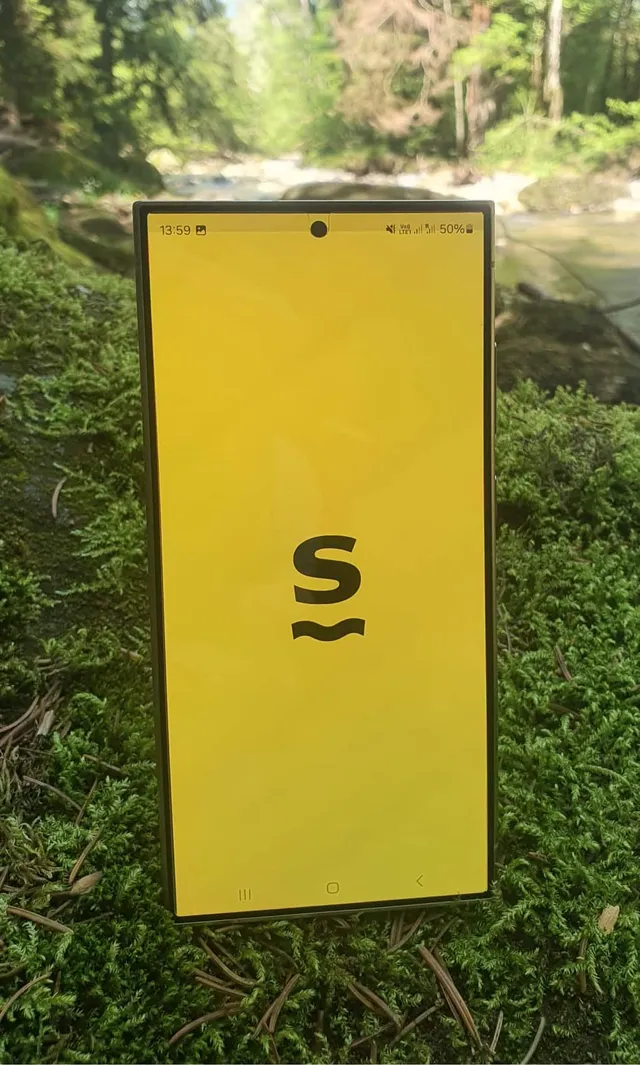
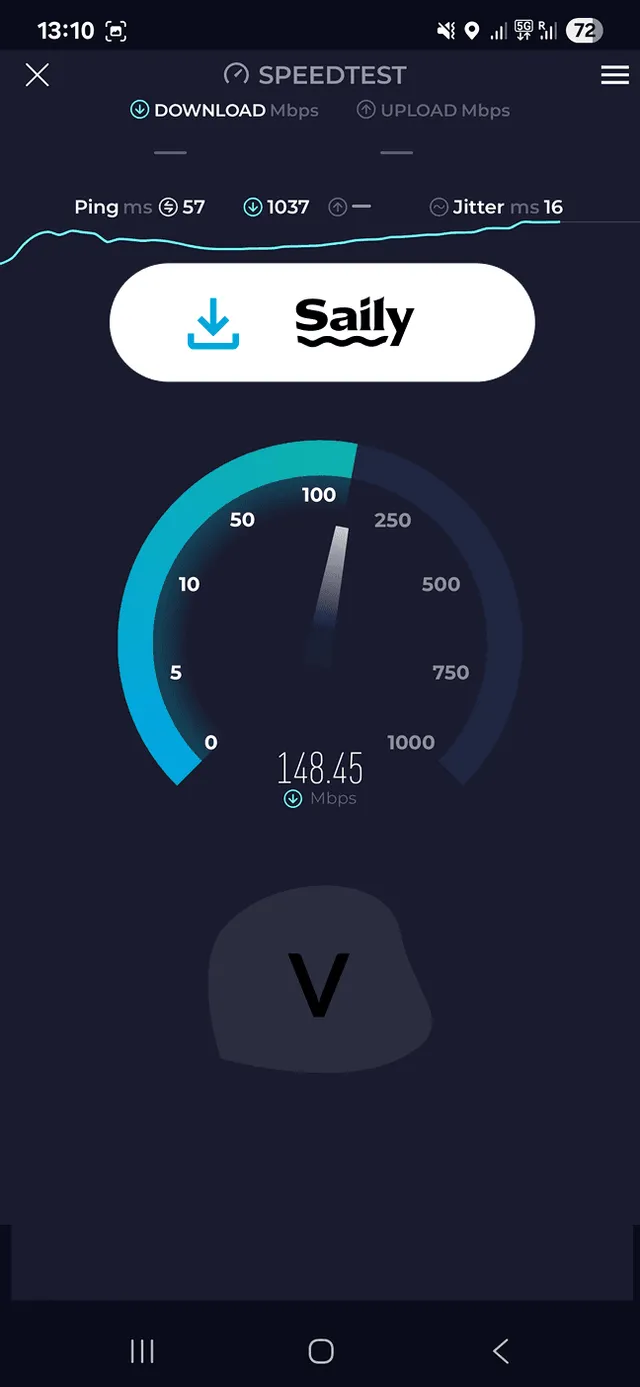
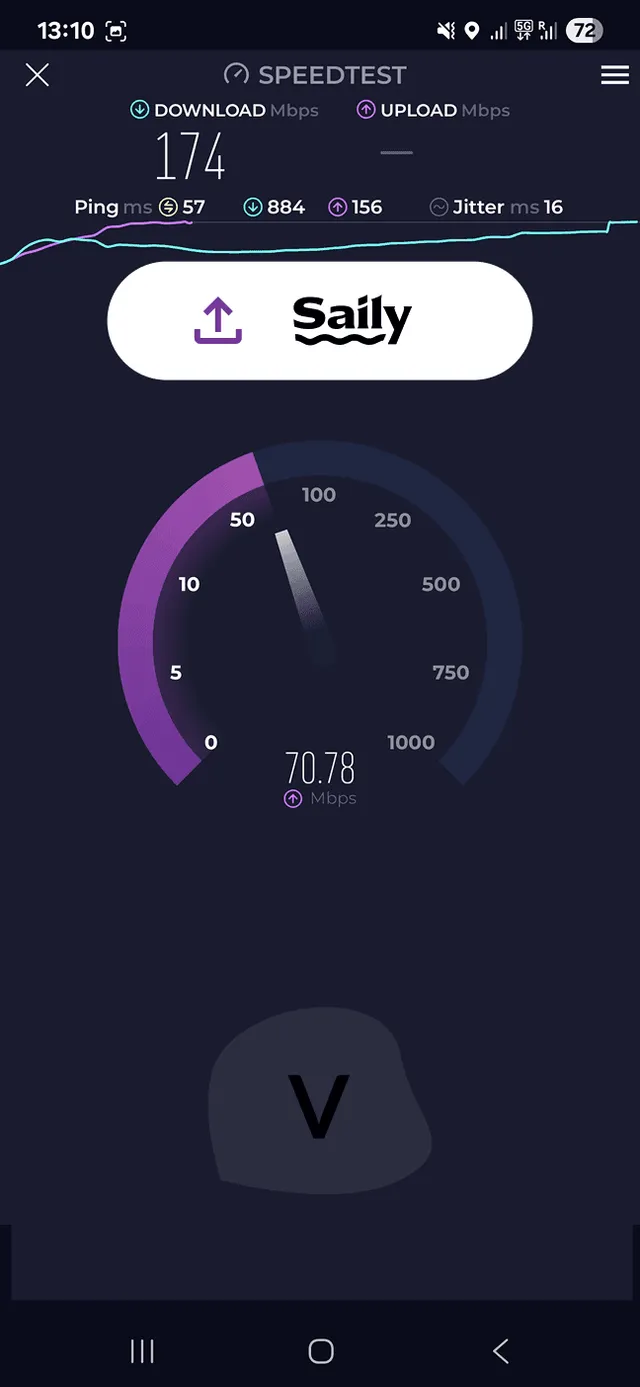
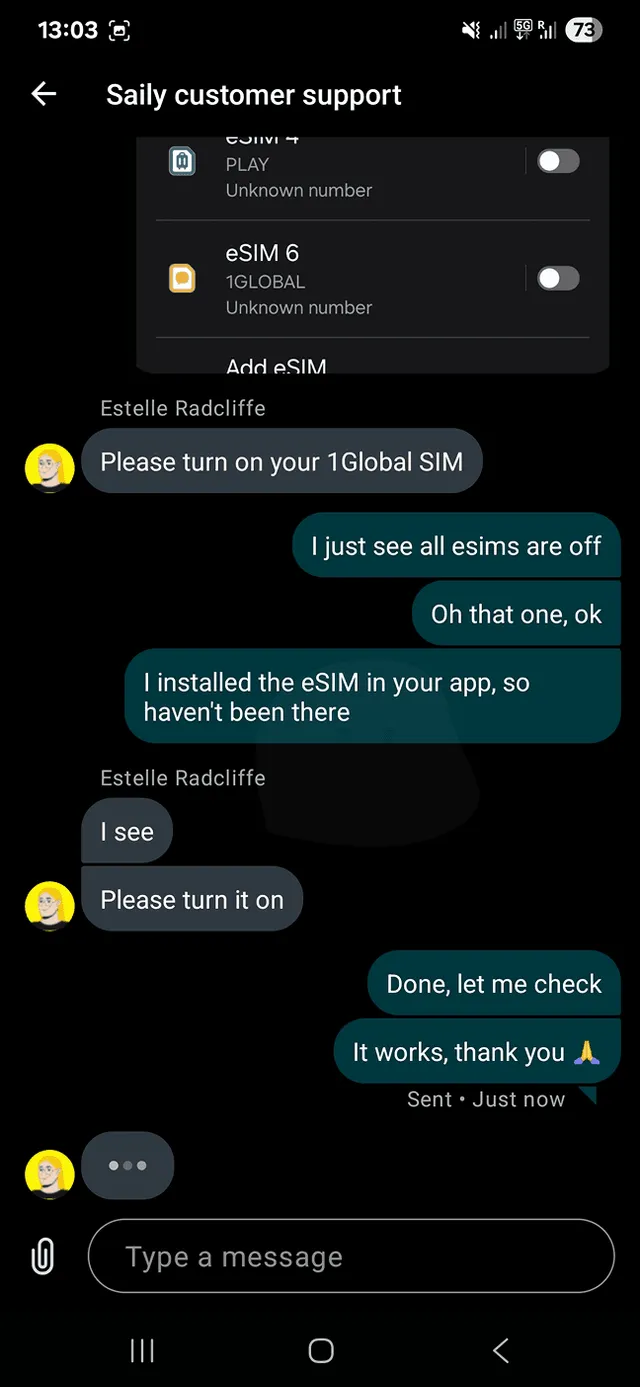
Saily connects to the best local network carriers in South Korea to provide stable and reliable internet connectivity. Created by the team behind NordVPN, Saily distinguishes itself with an exceptional app experience featuring intuitive design and sophisticated features. The Saily eSIM service connects to the best local network carriers to offer the most stable and reliable connection to the internet throughout South Korea. Their app includes integrated VPN capabilities, ad blocking, and web protection for enhanced data savings, making it particularly valuable in a privacy-conscious environment like South Korea. For detailed insights about Saily's offerings, check our comprehensive review.
Saily eSIM Plans in South Korea
Selection of the best eSIM data plans for SAILY in South Korea from 2 GB.
Global YO eSIM in South Korea - Usually the cheapest and calling in the app
Global YO offers eSIM plans with coverage in more than 200 countries. It stands out with very low prices and modern app design focused on younger generations, but has weaker customer support.
 200+ countries, eSIM for individual and multiple countries.
200+ countries, eSIM for individual and multiple countries. Modern app for iPhone.
Modern app for iPhone. Modern app for Android.
Modern app for Android. Supports data top-up.
Supports data top-up. Hotspot allowed.
Hotspot allowed. Speed according to local network.
Speed according to local network. Very low prices for data packages.
Very low prices for data packages. Smooth and quick eSIM installation.
Smooth and quick eSIM installation. Modern and stylish app.
Modern and stylish app. Option to add calling for an extra fee.
Option to add calling for an extra fee. Purchase only possible through the app.
Purchase only possible through the app. Slower customer support.
Slower customer support. App doesn't work after data is depleted.
App doesn't work after data is depleted.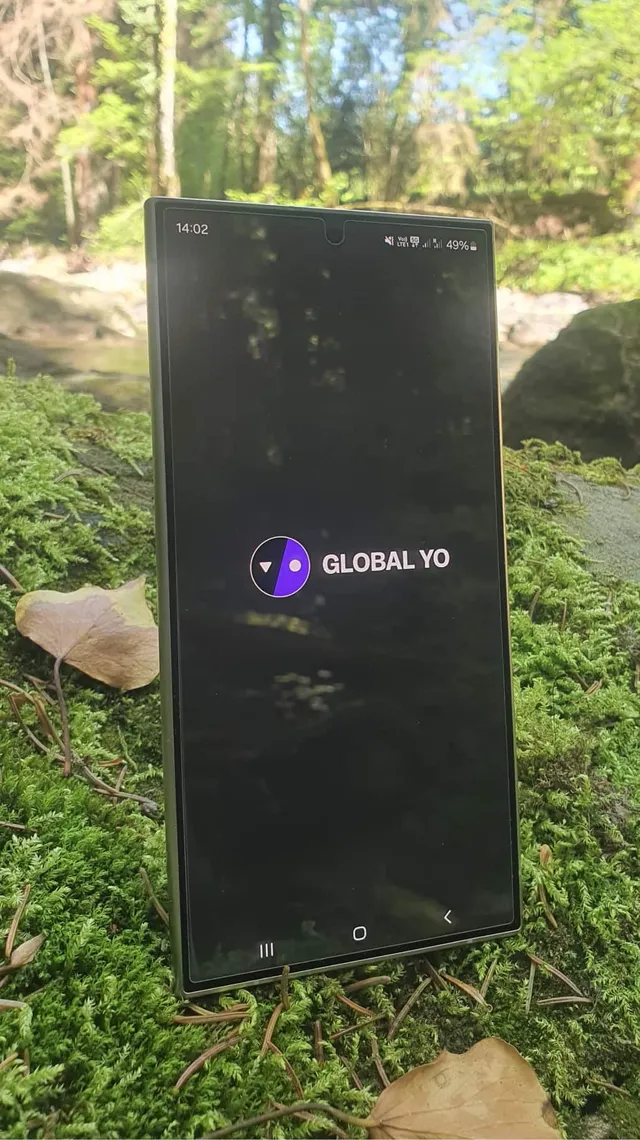
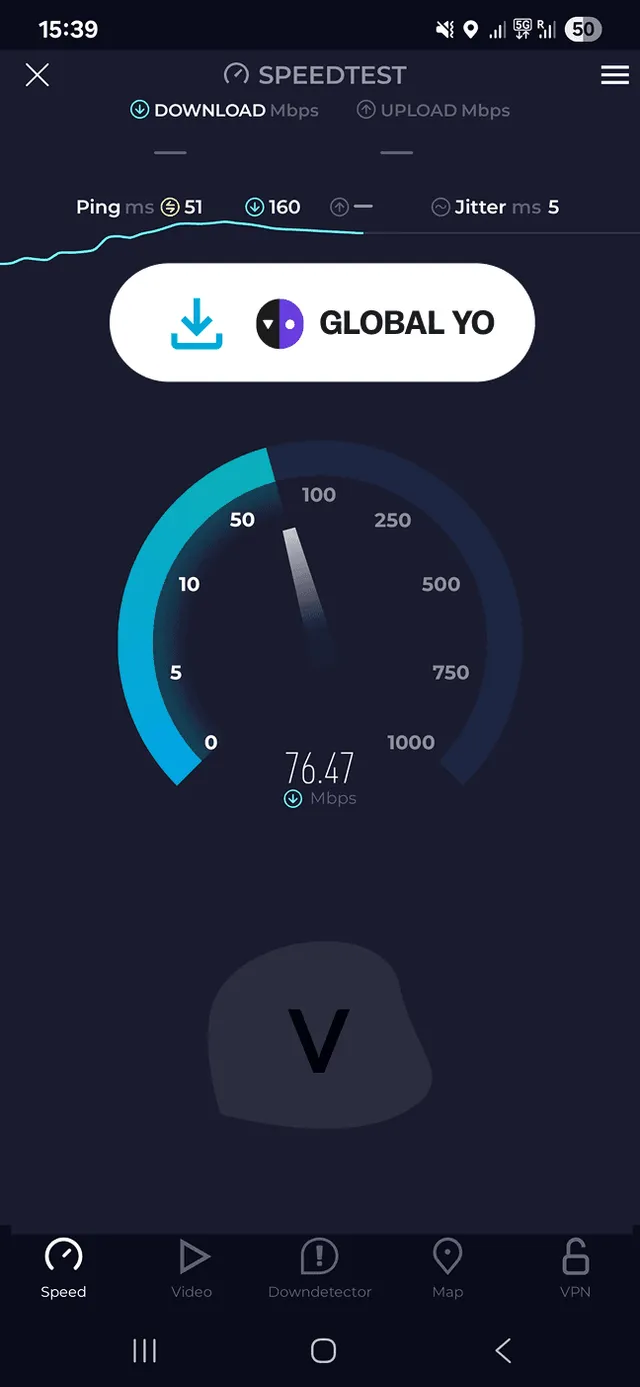
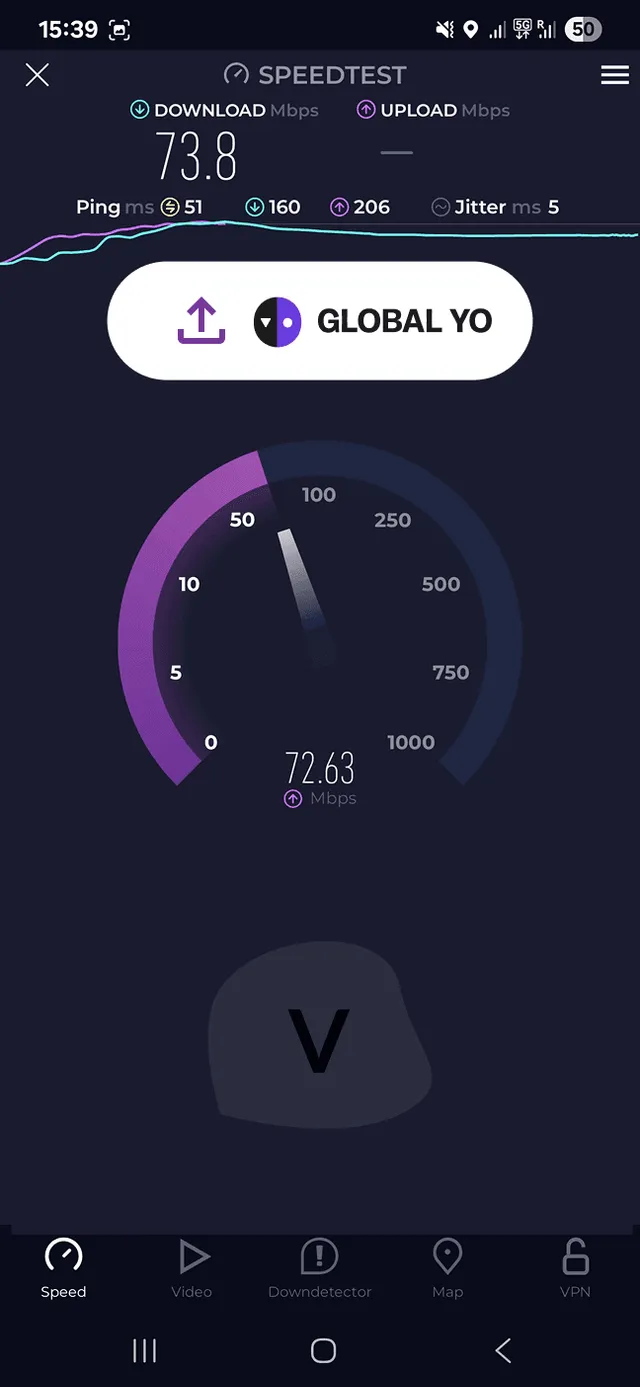
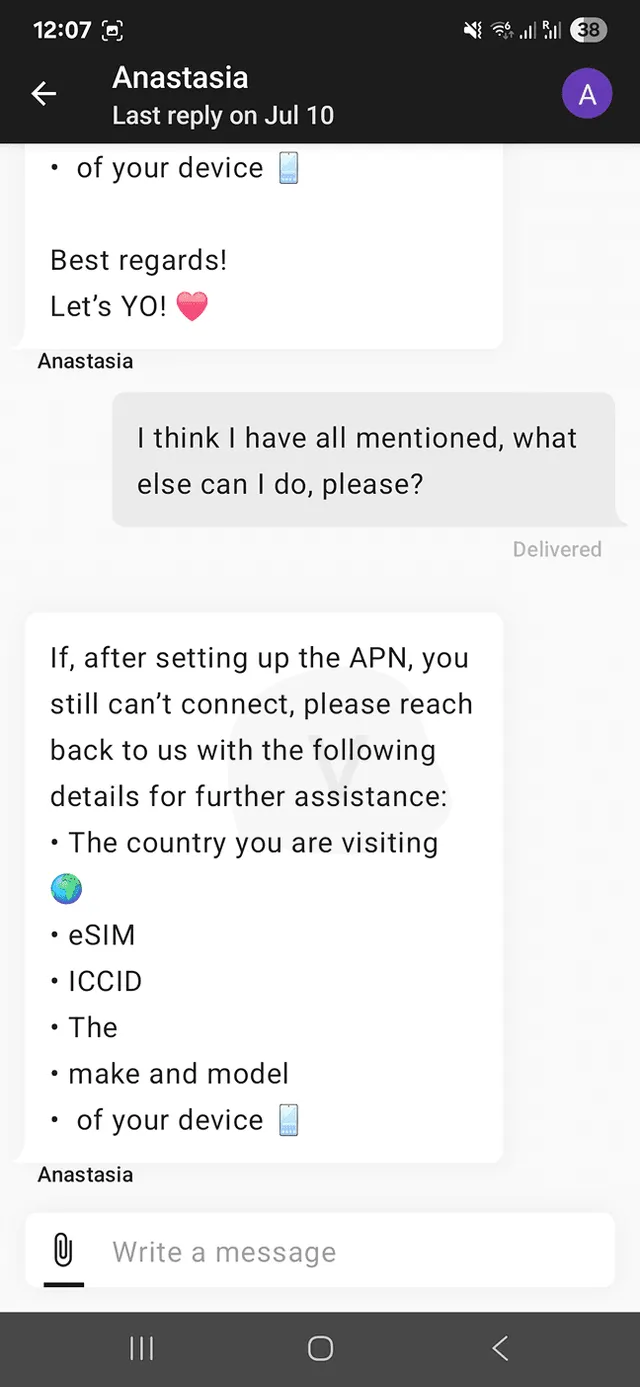
Global YO offers eSIM connectivity across South Korea by partnering with the country's leading mobile networks. Their service stands out with an exceptionally modern app design that appeals particularly to younger travelers. Global YO combines competitive pricing with a visually appealing interface and intuitive installation process. Their app includes unique features like an integrated travel map that tracks your journeys and activities throughout South Korea. Speed tests consistently show excellent performance, often exceeding 150 Mbps download in major Korean cities. For more comprehensive information about Global YO's services, visit our detailed guide.
Global YO eSIM Plans in South Korea
Selection of the best eSIM data plans for GLOBAL YO in South Korea from 2 GB.
GigSky eSIM in South Korea - Cheap unlimited & App that works without data
GigSky offers eSIM plans with coverage in more than 200 countries. It excels with unique connectivity on cruise ships and airplanes, but has shortcomings in the app's user interface.
 200+ countries, eSIM for individual and multiple countries.
200+ countries, eSIM for individual and multiple countries. Average app on iPhone. 4.6 from 1,321 reviews.
Average app on iPhone. 4.6 from 1,321 reviews. Average app on Android. 3.2 from 555 reviews.
Average app on Android. 3.2 from 555 reviews. Supports data top-ups.
Supports data top-ups. Hotspot allowed.
Hotspot allowed. Speed limited according to Fair Use.
Speed limited according to Fair Use. Unique coverage on cruise ships and airplanes.
Unique coverage on cruise ships and airplanes. Functions as a virtual operator with its own network.
Functions as a virtual operator with its own network. App remains partially functional even after data depletion.
App remains partially functional even after data depletion. Excellent customer support with quick response.
Excellent customer support with quick response. Requires app installation for eSIM purchase and management.
Requires app installation for eSIM purchase and management. Less intuitive app user interface.
Less intuitive app user interface. Slower connection speeds in some locations.
Slower connection speeds in some locations. More difficult to find technical information like ICCID.
More difficult to find technical information like ICCID.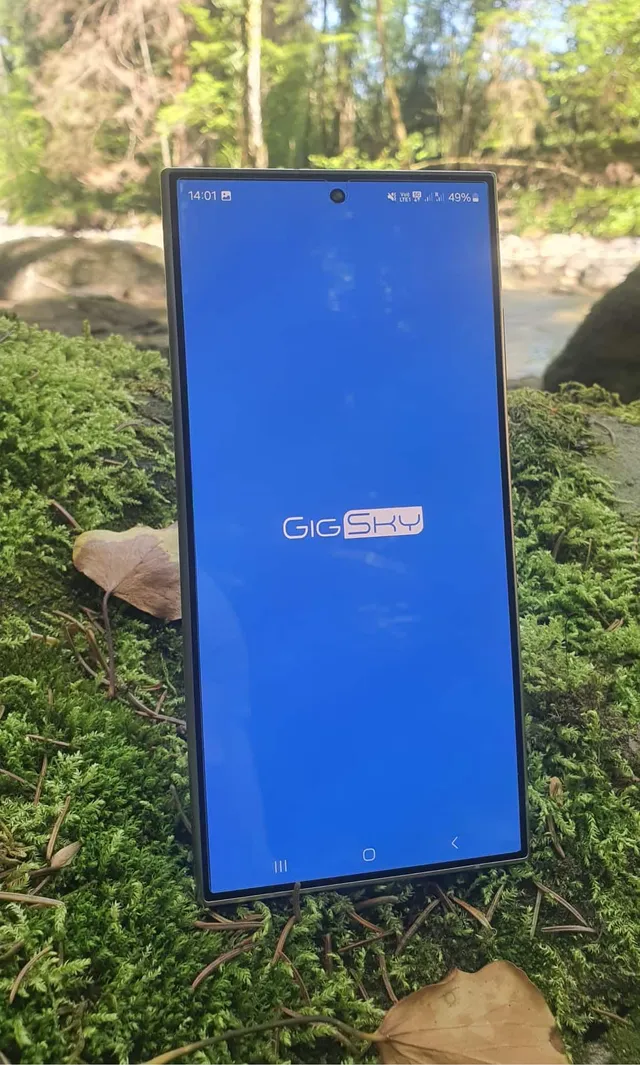
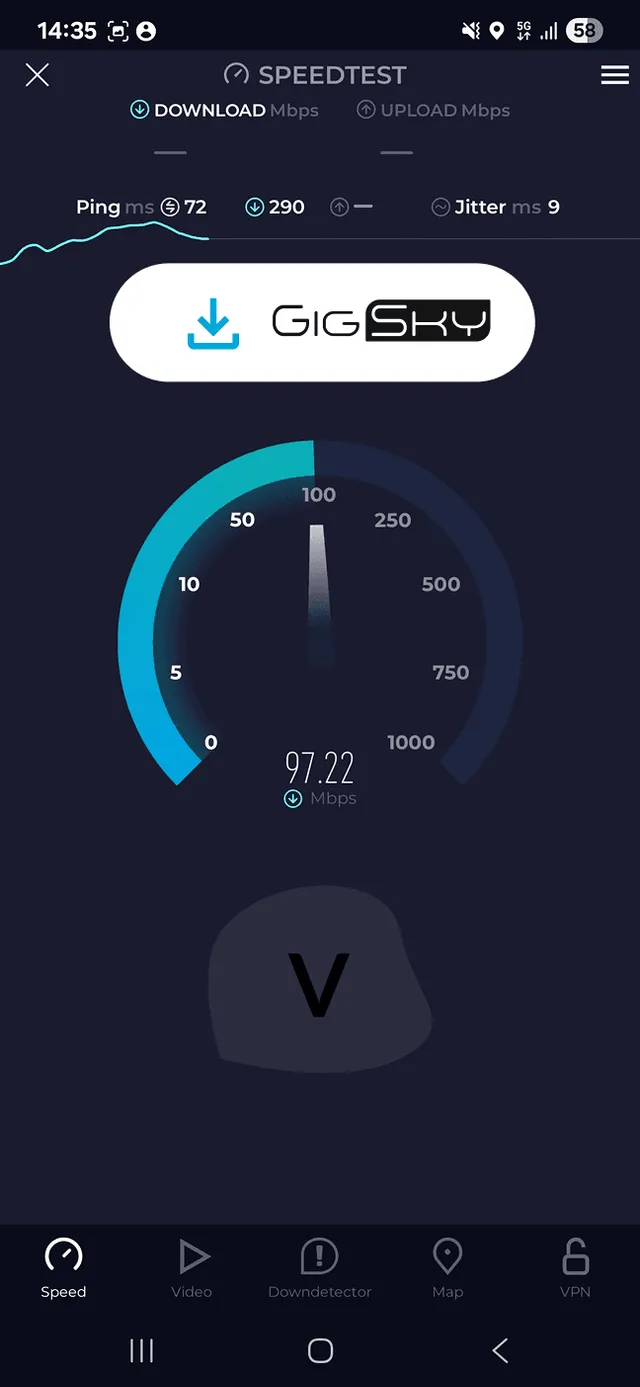
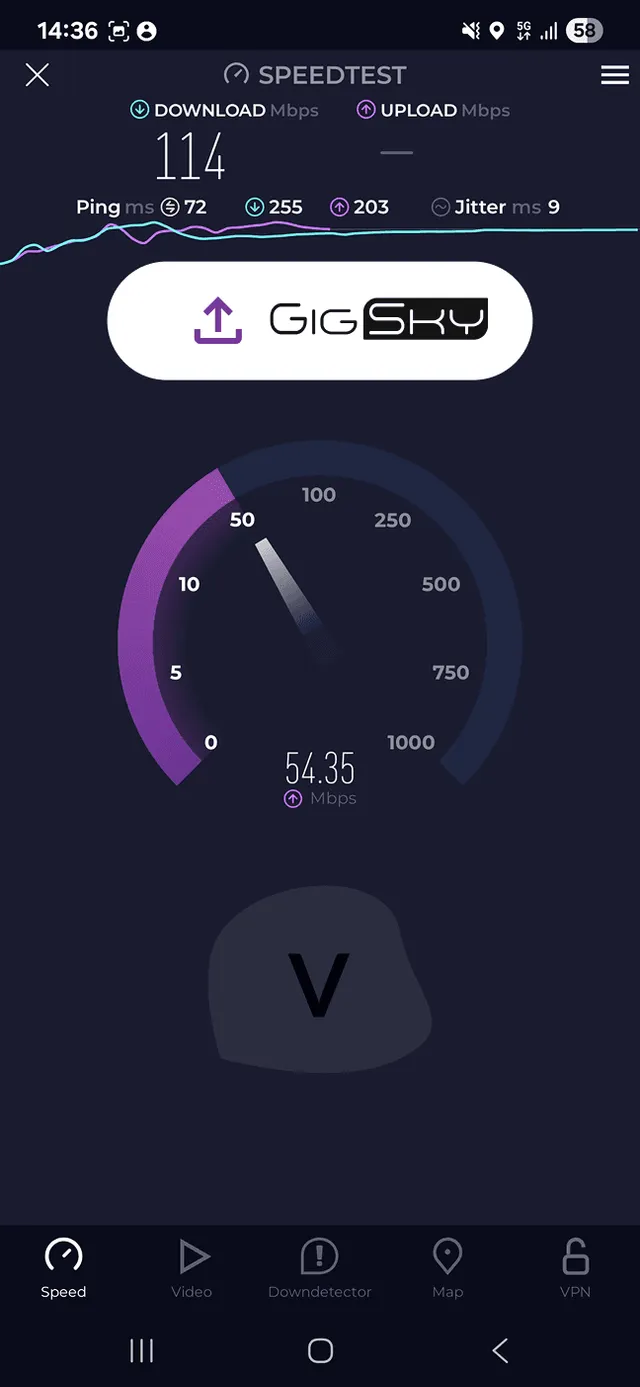
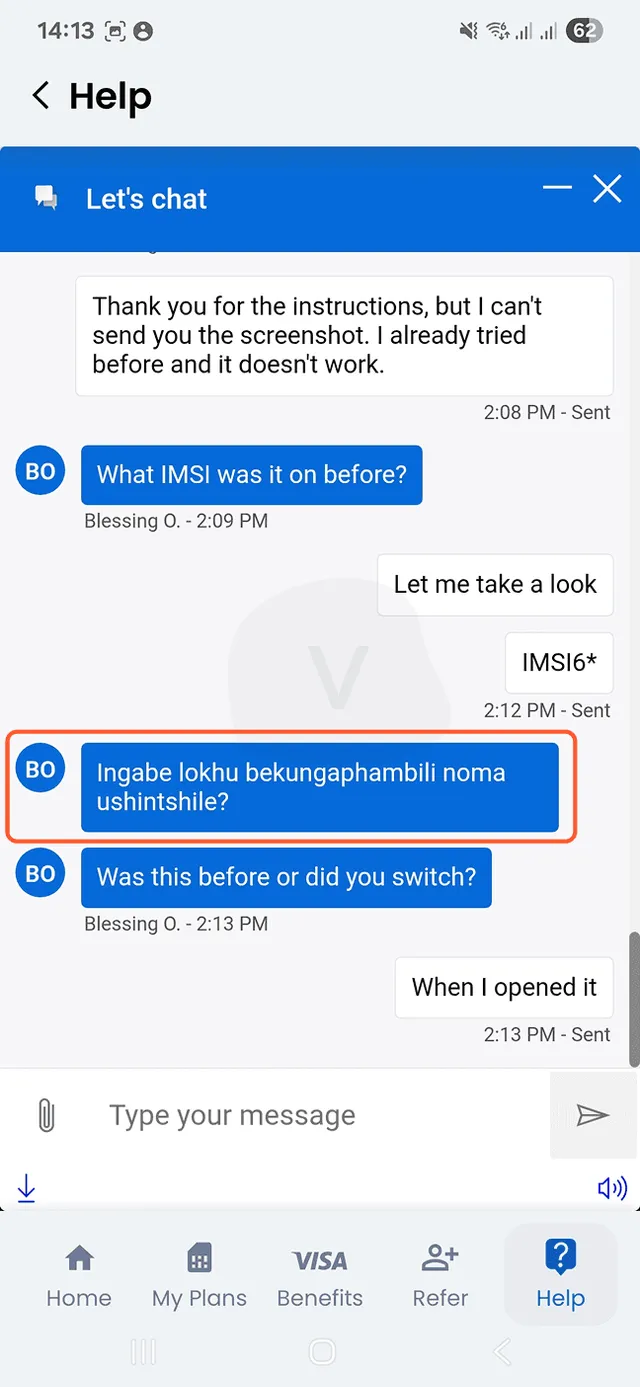
GigSky delivers the fastest network connectivity in South Korea, functioning as a virtual operator with its own network infrastructure. This approach ensures consistent performance across the country, from Seoul's bustling metropolitan areas to coastal cities like Busan. GigSky distinguishes itself with excellent customer support that responds promptly to inquiries. A unique advantage of their service is that their app remains partially functional even after data depletion, allowing you to easily purchase additional data without needing WiFi access. GigSky also offers unique coverage options for travelers taking cruises around the Korean peninsula or flying domestically within South Korea. For a more detailed exploration of GigSky's offerings, see our complete review.
GigSky eSIM Plans in South Korea
Selection of the best eSIM data plans for GIGSKY in South Korea from 2 GB.
Yesim eSIM in South Korea - Data from a Swiss eSIM provider
Yesim is a Swiss eSIM provider with coverage in 135 countries, offering fixed and unlimited data packages at competitive prices. Best suited for experienced users who don't need much customer support.
 135 countries, local, regional and global eSIM (including unlimited).
135 countries, local, regional and global eSIM (including unlimited). Good iPhone app. 4.4 from 600 reviews.
Good iPhone app. 4.4 from 600 reviews. Average Android app. 3.6 from 2,000 reviews.
Average Android app. 3.6 from 2,000 reviews. Supports data top-ups.
Supports data top-ups. Hotspot allowed.
Hotspot allowed. Possible speed limitation with excessive use.
Possible speed limitation with excessive use. Excellent prices per GB of data.
Excellent prices per GB of data. Offers both fixed and unlimited data packages.
Offers both fixed and unlimited data packages. Fast activation and good connection speeds.
Fast activation and good connection speeds. Very slow and inefficient customer support.
Very slow and inefficient customer support. More complex purchasing process with occasional issues.
More complex purchasing process with occasional issues. Inaccurate display of remaining data in the app.
Inaccurate display of remaining data in the app.
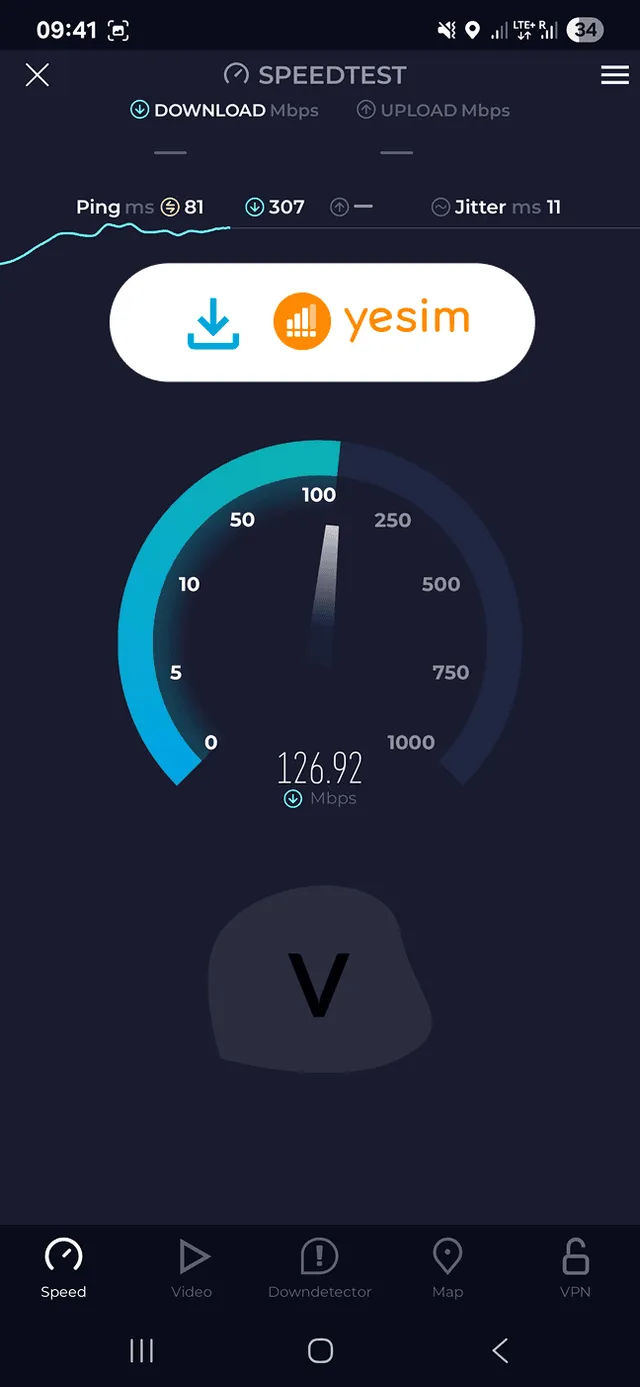
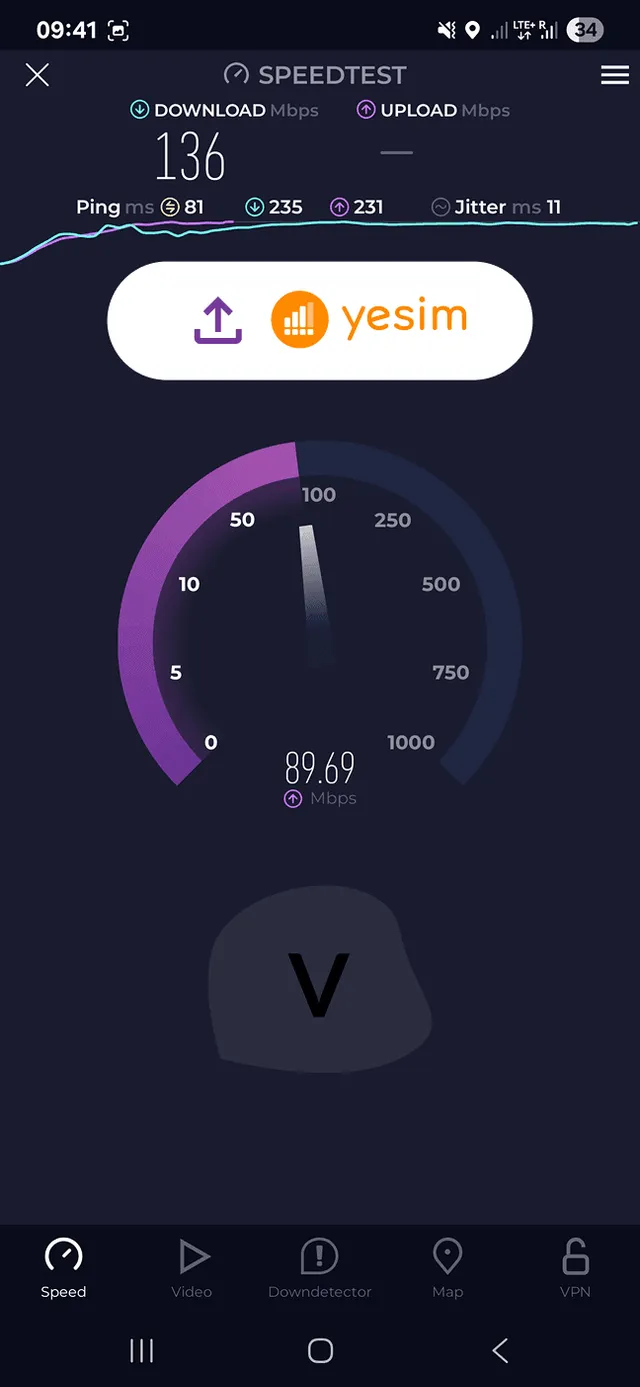
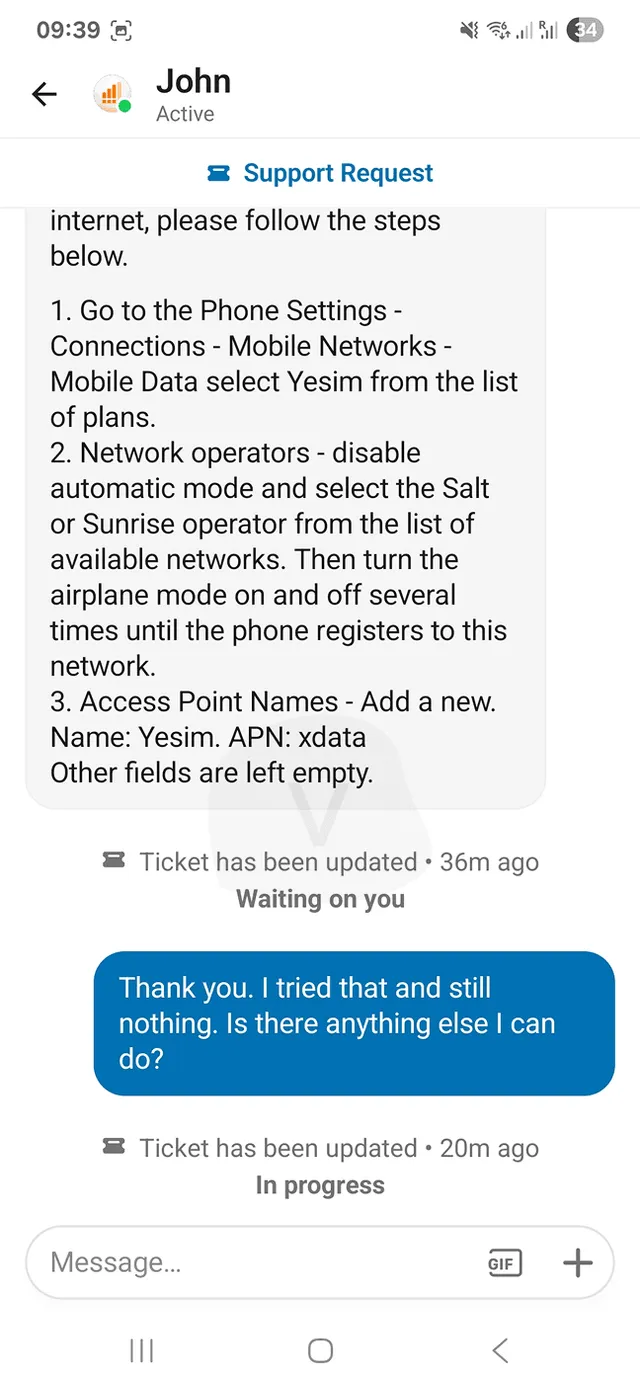
Yesim provides seamless mobile internet connectivity throughout South Korea's major urban centers. Enjoy the seamless mobile internet in Busan, Changwon, Daegu, Daejeon, Goyang, Gwangju, Incheon, Seoul, Suwon, and other cities in South Korea. Their service offers competitive pricing and excellent connection speeds, with tests showing download speeds of up to 135 Mbps and upload speeds around 90 Mbps in metropolitan areas. Yesim provides both fixed data volume packages and unlimited options, giving travelers flexibility based on their needs. The installation process is straightforward, particularly for users familiar with eSIM technology. For comprehensive details about Yesim's services and capabilities, refer to our in-depth overview.
Yesim eSIM Plans in South Korea
Selection of the best eSIM data plans for YESIM in South Korea from 2 GB.
Best eSIM Plans for South Korea
Below is a comparison of the most popular eSIM data packages for South Korea. To explore all available options and customize your search, use our comprehensive South Korea eSIM comparison tool, which allows you to filter offers by data volume, validity period, and additional features to find your perfect korea esim.
2 GB in South Korea
Comparison of offers for 2 GB data plans in South Korea from the most popular eSIM providers.
5 GB in South Korea
Comparison of offers for 5 GB data plans in South Korea from the most popular eSIM providers.
10 GB in South Korea
Comparison of offers for 10 GB data plans in South Korea from the most popular eSIM providers.
20 GB in South Korea
Comparison of offers for 20 GB data plans in South Korea from the most popular eSIM providers.
Unlimited Plan in South Korea
Comparison of offers for unlimited data plans in South Korea from the most popular eSIM providers.
Free Data in South Korea
For travelers needing minimal connectivity for basic tasks like checking emails or quick messaging, Roamless offers 350 MB of free data in South Korea. This can be particularly useful for brief layovers or when you first arrive before purchasing a full data package.
Another excellent option is GigSky, which provides a complimentary eSIM with 100 MB of test data without requiring payment card information. This trial allows you to experience how eSIM technology functions in South Korea before committing to a paid plan, ensuring compatibility with local networks.
For more comprehensive information about obtaining free data while traveling, explore our detailed article Free eSIM | How to Get Free Data for USA and Abroad. If you're seeking a complete overview of all available options including free offers, utilize our South Korea eSIM comparison tool.
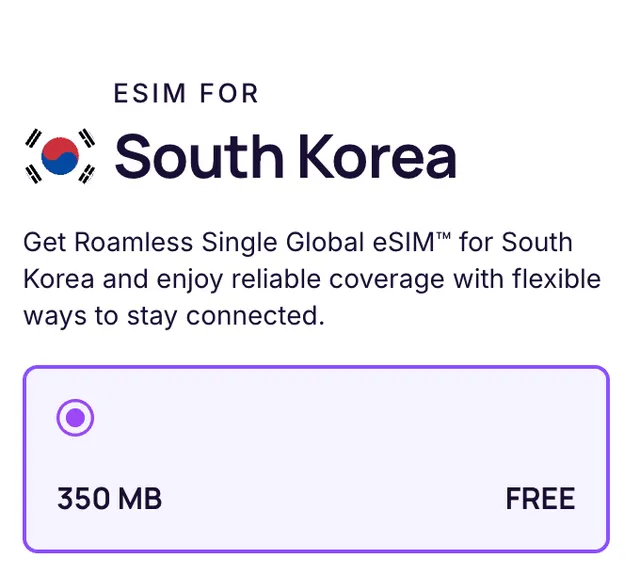
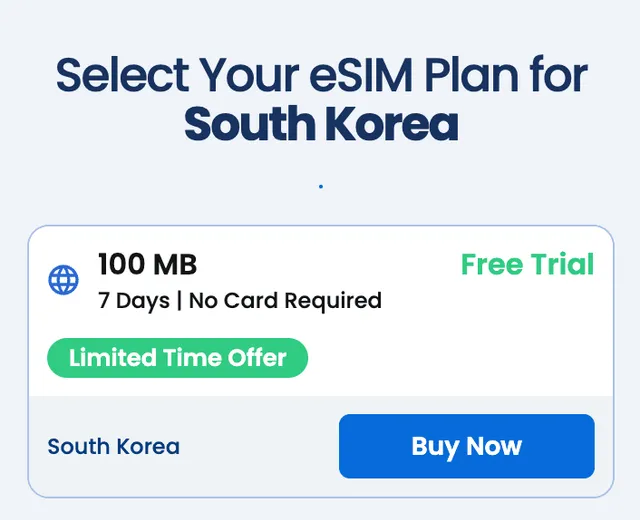
How to Set Up eSIM for South Korea
Setting up a Korea eSIM is a straightforward process that saves significant time and eliminates hassle during your travels. The primary advantage is completing all necessary preparations from home before departure, avoiding the need to locate SIM vendors upon arrival or navigate language barriers.
- Step-by-step guide for activating eSIM on iPhone
- Simple instructions for setting up eSIM on Samsung devices
- Complete list of devices supporting eSIM technology
1. Confirm device compatibility: Prior to purchasing a Korea eSIM, verify that your device supports this technology. Most recent models from major manufacturers like Apple, Samsung, and Google are fully compatible. If uncertain, consult our updated list of eSIM-compatible phones or best phones with eSIM support.
2. Select an appropriate provider: For South Korea, several reliable options are available, including eSIM4Travel, Saily, Global YO, GigSky, and Yesim. When choosing a data package, consider your trip duration and planned activities – for typical usage of navigation apps and social media, 2 GB is generally sufficient, while more intensive users should consider 5 GB or 10 GB packages. For the most precise comparison tailored to your needs, we recommend our South Korea eSIM comparison tool.
3. Install using QR code: After purchase, you'll receive an email containing a QR code or activation code. Navigate to your phone's settings, locate the "Mobile Data" or "Cellular" section, and select "Add Data Plan" or "Add eSIM." Scan the provided QR code and follow the on-screen prompts. If you've only received an activation code, you can easily convert it to a QR code using online tools.
4. Configure connection settings: In most instances, the connection configures automatically once installation completes. If not, you may need to manually enter the APN (access point) according to the provider's instructions. Ensure that data roaming is enabled for your eSIM profile – this won't incur additional charges with a proper eSIM plan.
We strongly recommend installing and configuring your Korea eSIM before departure, preferably with a stable Wi-Fi connection. This ensures immediate connectivity upon arriving in South Korea without complications. For additional information about first-time setup, explore our comprehensive eSIM for Travel guide.
Tips for Using eSIM in South Korea
South Korea offers visitors an incredible blend of ancient cultural heritage and technological advancement. Whether you're exploring Seoul's vibrant neighborhoods, visiting historic temples, or enjoying the coastal beauty of Busan, reliable internet connectivity enhances every aspect of your journey. Here are essential tips to maximize your Korea eSIM experience:
Navigating Language Barriers
Despite South Korea's technological prowess, language barriers can present challenges for international visitors. Having a reliable internet connection through your eSIM enables real-time translation apps like Google Translate or Papago (particularly effective for Korean). Download the Korean language pack before your trip for offline translation capabilities. Additionally, consider installing Naver Map or Kakao Map, which often provide more accurate navigation in Korea than Google Maps.
Data Management Strategies
Effective monitoring of data usage helps avoid unexpected limitations. Most eSIM providers offer dedicated apps for tracking consumption, and you can also configure alerts directly on your device. For maximum data efficiency during your Korean adventure, review our article Saving Data on Vacation | Proven Tips and Tricks, which includes valuable recommendations such as:
- Pre-downloading Seoul subway maps and city guides for offline use
- Adjusting streaming quality settings for platforms like YouTube and Netflix
- Disabling automatic cloud uploads and app updates
- Utilizing Korea's excellent public Wi-Fi for data-intensive activities
If you're uncertain about your data requirements for South Korea, consult our guide How Much Data Do You Need for Various Activities, which will help determine the appropriate package size. For precise selection based on your specific needs, use our eSIM comparison tool.
Essential Korean Apps
South Korea has its own ecosystem of popular apps that significantly enhance the travel experience. With your eSIM providing reliable connectivity, consider installing:
- KakaoTalk: The dominant messaging platform in Korea, useful for communicating with locals or Korean businesses
- Naver Map: Often more detailed than Google Maps for navigating Korean cities and finding public transportation
- Yogiyo or Baemin: Popular food delivery apps if you want to order Korean cuisine to your accommodation
- Kakao T: Korea's equivalent to Uber for taxi services
Financial Services and Payments
South Korea is increasingly accepting of international payment methods, but having digital banking access remains essential. Services like Revolut or Wise provide favorable exchange rates for Korean Won. With your Korea eSIM keeping you connected, you'll maintain constant access to your financial accounts and mobile payment platforms. Note that while credit cards are widely accepted in urban areas, smaller establishments and traditional markets often prefer cash.
Regional Travel Considerations
Planning to visit neighboring countries like Japan or China? Many providers offer regional eSIM packages for East Asia that include South Korea along with other destinations. These packages typically provide better value than purchasing separate eSIMs for each country. To find the most advantageous regional option, use our eSIM comparison tool, where you can specify exactly which countries you'll visit. Also explore our guides for Japan if you're planning a multi-country Asian itinerary.
✈️ Expert tip: South Korea has excellent public transportation, particularly in Seoul. Download the Korea Metro app to navigate the extensive subway system efficiently. Also, save the location of your accommodation offline, as addresses in Korea can be complex and confusing for visitors unfamiliar with the local addressing system.
Alternative Internet Connections in South Korea
While eSIM technology offers a convenient and modern solution for staying connected in South Korea, it's not the only option available. If eSIM isn't suitable for your needs or device, consider these alternatives:
Traditional Physical SIM Cards
Local Korean SIM cards are readily available at Incheon and Gimhae International Airports, major electronics stores, and convenience chains like CU or GS25. The primary providers are SK Telecom, KT (Korea Telecom), and LG U+, all offering tourist-specific packages with data, calls, and messaging services.
The advantages of physical SIM cards include competitive pricing (typically ₩30,000-50,000 or $25-40 for a 7-10 day package) and access to a local phone number for calls and SMS. The main disadvantages are the requirement to visit a physical location after arrival, potential communication challenges during purchase, and the need to remove your home SIM card if your device doesn't support dual SIM functionality.
If you opt for a physical SIM card, we recommend purchasing from official airport booths or carrier stores in shopping districts like Myeongdong in Seoul. These official vendors will require your passport for registration, which is mandatory under Korean telecommunications regulations. Avoid unofficial vendors who might offer unregistered cards that could be deactivated without notice.
Portable Wi-Fi Hotspots
Pocket Wi-Fi rentals are extremely popular in South Korea, with numerous providers offering these devices at airports and online for pre-booking. These compact devices create personal Wi-Fi networks that can connect multiple devices simultaneously – ideal for families or groups traveling together with multiple smartphones, tablets, and laptops.
Rental services like KT Olleh and SK Telecom offer competitive rates starting from approximately ₩5,000-8,000 ($4-7) per day, with discounts for longer rental periods. Many accommodations and tour companies also provide free or discounted pocket Wi-Fi as part of their services. For more information about these devices, refer to our guide Best Portable WiFi Hotspots for Travel.
The primary disadvantages of portable hotspots are the need to carry and regularly charge an additional device, potential rental deposits (usually refundable), and the responsibility of returning the device before departure, which can add stress to your final day in Korea.
International Roaming
Using your home carrier's roaming services is the most convenient but typically most expensive connectivity option. Roaming functions through agreements between your domestic provider and Korean networks, allowing continued use of your existing number and plan while abroad.
Standard roaming rates for South Korea can be prohibitively expensive, often ranging from $10-15 per day for limited data packages to several dollars per megabyte for pay-as-you-go usage. Some carriers offer special travel passes for Korea or Asia, which provide fixed daily rates for limited data usage. While these packages offer predictable costs, they remain significantly more expensive than local solutions or eSIMs.
Public Wi-Fi Networks
South Korea boasts exceptional public Wi-Fi infrastructure, particularly in Seoul and other major cities. The government-supported "Public WiFi Free" network is available in many public spaces, tourist attractions, and transportation hubs. Additionally, virtually all cafes, restaurants, shopping malls, and even subway stations offer free Wi-Fi access.
To access these networks more easily, download the "Korea WiFi" app before your trip, which helps locate and connect to free public networks throughout the country. However, be aware that public networks, while convenient, present security vulnerabilities. Always use a VPN when connecting to public Wi-Fi, especially for sensitive activities like banking or accessing personal accounts.
Relying exclusively on public Wi-Fi limits your connectivity to areas with available networks, which can be problematic when navigating unfamiliar locations or during emergencies. Therefore, we recommend having at least one backup connectivity solution, whether an eSIM, local SIM, or portable hotspot.
Mobile Networks and Operators in South Korea
South Korea possesses one of the world's most advanced telecommunications infrastructures, consistently ranking among global leaders for internet speed and mobile network coverage. Understanding the local market helps you select the optimal eSIM or alternative connectivity solution for your visit.
Major Korean Mobile Operators
SK Telecom (SKT) is Korea's largest mobile carrier, commanding approximately 42% market share. Known for exceptional network quality and extensive coverage, SKT consistently leads in network speed tests across the country. Their network covers virtually 100% of populated areas, including remote islands and mountainous regions. SK Telecom was also the first to launch a commercial 5G network in Korea, offering lightning-fast connectivity in major urban centers.
KT (Korea Telecom), formerly the state-owned monopoly, holds roughly 31% of the market and provides excellent coverage nationwide. KT is particularly strong in Seoul and surrounding metropolitan areas, with robust infrastructure extending to rural regions. Their network is known for stability and consistent performance, making it a reliable choice for travelers venturing beyond major cities.
LG U+, the third major carrier, controls approximately 25% of the market. Despite being smaller than its competitors, LG U+ has invested heavily in network infrastructure and often outperforms the larger carriers in specific regions, particularly in newer residential developments and certain business districts. Their aggressive pricing strategies make them popular with cost-conscious consumers.
Coverage and Network Quality
Mobile coverage in South Korea is exceptional by global standards, with all three major carriers providing near-universal 4G LTE coverage across populated areas. In Seoul, Busan, Incheon, and other major cities, you can expect consistent 5G connectivity with download speeds regularly exceeding 500 Mbps. Even in subway tunnels, mountain hiking trails, and remote beaches, 4G coverage remains remarkably reliable.
South Korea's commitment to technological leadership has resulted in the world's first nationwide 5G network, with coverage expanding rapidly beyond urban centers. As of 2025, 5G coverage extends to approximately 85% of populated areas, with the remaining regions well-served by robust 4G LTE networks. This advanced infrastructure ensures that travelers with 5G-capable devices can experience exceptional connection speeds throughout most of their journey.
For real-time coverage information in specific areas of South Korea, we recommend consulting nPerf.com's interactive coverage maps, which provide detailed insights into which carrier offers optimal signal strength in your planned destinations.
Which Networks Do eSIM Providers Use?
International eSIM providers partner with local Korean carriers to deliver their services. Here's an overview of the network relationships for major eSIM providers in South Korea:
- eSIM4Travel: Primarily uses SK Telecom's network, providing excellent nationwide coverage
- Jetpac: Partners with KT (Korea Telecom) for reliable connectivity
- Saily: Utilizes multiple carrier networks, automatically selecting the strongest signal
- Global YO: Works with various Korean networks to ensure optimal connectivity
- Yesim: Connects to multiple networks for comprehensive urban coverage
- GigSky: Provides access to the fastest available networks across Korea
When selecting an eSIM provider for South Korea, consider your itinerary carefully. For predominantly urban travel focused on Seoul, Busan, and other major cities, any provider will deliver excellent performance. If your plans include visits to more remote areas like Jeju Island, mountainous national parks, or rural countryside, providers using SK Telecom or offering multiple network access may provide more consistent connectivity. For personalized recommendations based on your specific travel plans, use our South Korea eSIM comparison tool.
How to Call from South Korea with eSIM
Maintaining communication with family, colleagues, or local contacts is essential during your Korean journey. With a data eSIM, you have several efficient options for making calls without incurring excessive international charges.
Internet-Based Calling via Data eSIM
Most Korea eSIM packages provide data-only service without traditional voice calling capabilities. However, this limitation is easily overcome using Voice over Internet Protocol (VoIP) applications that leverage your data connection for high-quality calls.
KakaoTalk is South Korea's dominant messaging platform, used by over 90% of smartphone users in the country. Beyond text messaging, it offers excellent voice and video calling features. Installing KakaoTalk is highly recommended for communicating with Korean contacts, as locals strongly prefer it over other platforms. For international calls to family and friends, familiar options like WhatsApp, FaceTime, and Messenger work perfectly with your eSIM data connection.
For calling standard phone numbers worldwide, consider apps like Skype or Google Voice, which offer competitive rates for international calling. Skype's pay-as-you-go rates for calling landlines and mobiles in most countries start at just a few cents per minute, significantly cheaper than traditional international calling.
For comprehensive information about internet calling options, explore our dedicated article Calling from Data eSIM | How to Make Calls Cheaply from Abroad, which provides detailed guidance on VoIP services and strategies for minimizing communication costs.
Local Korean Phone Number Options
If having a local Korean phone number is essential for your trip—perhaps for business purposes or receiving verification codes from local services—several options exist beyond traditional SIM cards.
Some eSIM providers now offer virtual local numbers as add-on services to their data packages. These virtual numbers allow you to receive calls and SMS messages on a Korean number while using your data eSIM. Check with your specific provider to see if this service is available for South Korea.
Alternatively, specialized apps like Line Out (from the popular Line messaging app) allow you to purchase a virtual Korean number for receiving calls and SMS. These services typically charge a small monthly fee but can be more cost-effective than maintaining a separate physical SIM card solely for voice services.
Emergency Communication
For emergency situations in South Korea, it's important to know that the universal emergency number is 112 for police and 119 for fire/medical emergencies. Most modern smartphones can make emergency calls even without an active SIM card or when locked, but having a functioning eSIM provides additional security.
The Korean government also operates a dedicated tourist helpline at 1330, available 24/7 with English, Japanese, and Chinese support. This service can assist with translation during emergencies, provide information, or help with reporting issues. Save this number in your contacts before traveling.
When traveling in more remote areas of South Korea where cellular coverage might be limited, consider downloading offline maps and translation tools as backup. Some hiking areas and national parks may have spotty coverage, so inform someone of your itinerary when venturing into such regions.
Frequently Asked Questions about eSIM in South Korea
Frequently Asked Questions
Do I need a Korea eSIM if my hotel offers free Wi-Fi?
Which eSIM provider offers the best coverage in Seoul and Busan?
Will my Korea eSIM work in the DMZ or on Jeju Island?
Can I use Korean payment apps like KakaoPay with an eSIM?
How much data do I need for a week in South Korea?
Will my Korea eSIM work in the subway system?
Can I use a Korea eSIM to access websites or services that are restricted in other countries?
Summary
Traveling through South Korea becomes significantly more enjoyable with the convenience of eSIM technology. This modern solution eliminates the need to hunt for physical SIM cards, navigate language barriers at local stores, or pay excessive roaming fees. By arranging your connectivity before departure, you'll be online within minutes of arrival, ready to explore this fascinating country.
In this comprehensive guide, we've compared the leading Korea eSIM providers including eSIM4Travel, Saily, Global YO, GigSky, and Yesim. Each offers distinct advantages, with selection depending on your trip duration, data requirements, and personal preferences.
Among the most popular data packages for South Korea are 5 GB for standard usage, 2 GB for brief visits, 10 GB or 20 GB for extended stays, and unlimited plans for data-intensive activities like remote work or frequent video streaming.
For travelers seeking an economical yet reliable solution, eSIM4Travel presents an excellent value proposition. Their service activates promptly after installation, their support team responds quickly with personalized assistance, and their pricing structure is among the most competitive in the market. Without speed limitations or mandatory app installations, they offer the flexibility to purchase additional data directly for your existing eSIM when needed.
For users who prioritize a premium app experience with integrated features, Saily delivers sophisticated functionality including built-in VPN capabilities and efficient customer support. Meanwhile, Global YO appeals to younger travelers with its modern design and competitive pricing.
We strongly recommend installing your Korea eSIM before departure. This preparation ensures immediate connectivity upon landing in South Korea, allowing you to navigate from the airport, communicate with accommodation providers, and begin exploring without delay.
For the most current and comprehensive comparison of all available Korea eSIM options, utilize our South Korea eSIM comparison tool, which enables filtering by data volume, validity period, and additional features to find the perfect solution for your specific requirements.

What is eSIM?
eSIM allows you to use a digital SIM card instead of a traditional plastic one. This enables you to purchase a SIM card online for the country you're traveling to.
The most well-known eSIM providers on the market are Airalo, Holafly, eSIM4Travel, Yesim, Saily and others.
Frequently asked questions about eSIM:
- Does my phone have eSIM?
- How to add eSIM to iPhone or Samsung?
- How to install eSIM on an older phone?
- What are the most affordable and best phones with eSIM support?

How to compare eSIM?
Here you can compare eSIM data packages for more than 170 countries, such as UK, USA, Egypt and others. And that for any duration and amount of data.
Along with additional information, such as provider ratings and whether the website is available in Czech.
Compare all eSIMs
Why can you trust Vefru?
Founders František and Jan experienced problems with mobile data every time they traveled outside the EU. As technology enthusiasts, the idea of traveling abroad without a data connection or risking truly insane roaming fees was unacceptable to them. Regardless of how adventurous the story of walking across Toronto on a winter night without an online map might be, it's not something they would want to repeat.
After the emergence of eSIM and later eSIM travel data package providers, they learned a lot about the technology and industry and decided to share their findings and the comparison tool they created for themselves with others. It now contains more than 10,000 updated eSIM mobile data packages from the most popular providers for more than 170 countries around the world.
Every time you read a guide on Vefru, it is created in the same way the author would research the topic themselves. From contacting locals about the best network operators, to recommending the most advantageous plans for what you really need, to technical guides on how to create a QR code for eSIM or how to troubleshoot eSIM issues. Most articles are created based on topics that the authors themselves have dealt with and for which they found the best solutions.
Technology experts
instead of copywriters
We test everything we
write about
We compare 10 thousand
eSIM data packages











